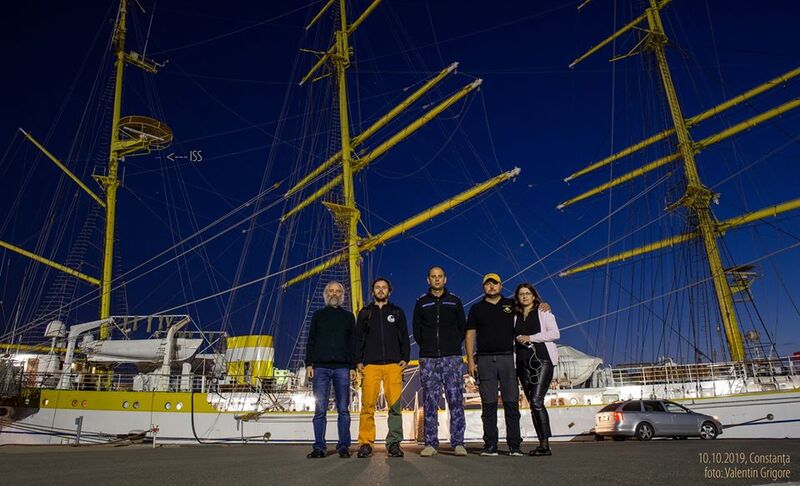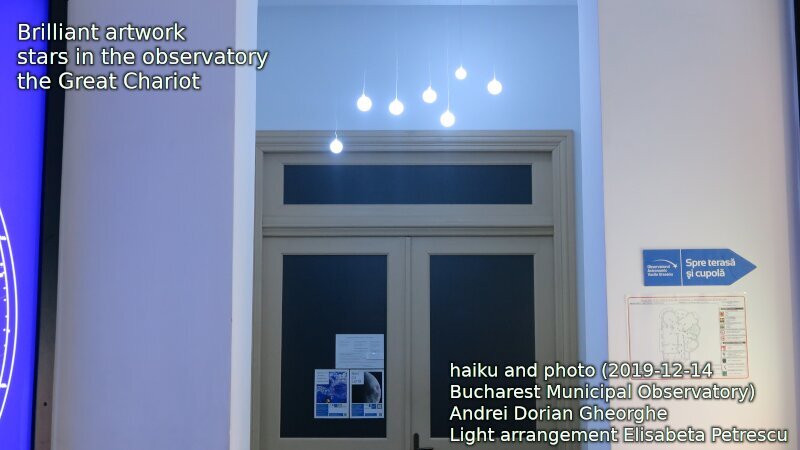ABOUT THE NEW INSIDE COSMOS
OF THE URSEANU OBSERVATORY
Text and photos Andrei Dorian Gheorghe
Mircea Brig photo Valentin Grigore
Design Florin Alexandru Stancu
The Sun was very bright for a few days in January 2019,
like an anticipation of more beautiful moments during that year,
and one of them rolled for me in the last quarter.

The picture from above, taken by the president of SARM in 2019-10-10,
is historical because:
-it was made through an exposure,
so its author is included in it (the first on the left, together with Sorin Bota,
Andrei Pocora, Comin Sorin Miclos and Daniela Mladin,
representatives of SARM, the Naval Academy and the Astronomer Disciple);
-it was made during a European project,
“A joint window open to the Universe’s mysteries”,
a Romania-Bulgaria cross-border program,
for which SARM and other associations and groups
were invited for a cruise to assist and learn the use
of the astronomical instruments of navigation on the Black Sea;
-it was made on the ship chosen for that cruise, the Mircea Brig,
even the school (training) ship of Romanian Navy
(named after Mircea the Elder, the “voievod” and ”domnitor” who
restituted the access to the Black Sea for the Romanians in the 1390s;
this brig was built in England and launched in 1882,
and replaced by a modern variant made in Germany in 1939);
-it caught the International Space Station
(indicated by an arrow near the left mast),
so we can say that the picture symbolically catches
two essential moments in humanity’s history,
navigation on water and navigation through space.
Since the first commandant of the Mircea Brig
was nobody else than the officer and…
amateur astronomer Vasile Urseanu,
in December 2019
I decided I had to re-visit (for the first time after the renovation)…
the Admiral Vasile Urseanu Bucharest Municipal Observatory,
which was made…
in the form of a yacht!
With astronomer Spiru Haret as minister of public instruction
(under the rulership of King Carol I - a sky lover, too)
astronomy lived a golden age in Romania before World War I:
-teacher Ion Otescu presented “Romanian Beliefs in Stars and Sky”
at the Romanian Academy in 1907;
-Victor Anestin founded the first Romanian astronomical magazine in 1907
and the first Romanian astronomical society in 1908,
and presented “Comets, Eclipses and Fireballs
that were observed in Romania in between 1396 and 1853,
after manuscripts and documents” at the Romanian Academy in 1912;
-Nicolae Coculescu founded the state observatory on 1908
(now the headquarters of the Astronomical Institute of the Romanian Academy);
-Admiral Vasile Urseanu was chosen president of
the Flammarion Romanian Astronomical Society in 1908
and made the first private observatory in Bucharest in 1910
(now the Bucharest Municipal Observatory).
*
In 2019-12-14 the astronomical-meteorological vision
of the Sun deformed by clouds
superposed, in my imagination, the non-astronomical vision
of an angel indicating the north.
Then the Sun caught
a blue, mysterious atmospheric aura.
On that afternoon I started to the Bucharest Municipal Observatory
and I admired the fence decorated by its team,
and its exterior, culminating with the expositional vision
of the legendary Zeiss lunette
(nicknamed Bertha, 150mm in diameter)
bought even by Admiral Vasile Urseanu.
Inside I felt myself welcomed by the busts of the terrible trio
of Romanian legendary amateur astronomers,
Victor Daimaca (discoverer of two comets during World War II),
Vasile Urseanu and Victor Anestin,
by the commemorative plaques for Urseanu and Anestin,
by the old stained glasses,
by a picture with the last but one coordinator, Dr. Harald Alexandrescu
and… by the current observatory team
(artist-astronomer Elisabeta Petrescu, coordinator Adrian Bruno Sonka
and telecope specialist Mihai Dascalu).
*
The history of this observatory is impressive,
connected to important personalities of Romanian astronomy
(whose names are carried by asteroids today):
Victor Anestin, Nicolae Donici, Constantin Popovici, George Demetrescu,
Matei Alexescu, Ion Corvin Sangeorzan, Harald Alexandrescu.
Since 2005 the observatory is coordinated by Adrian Bruno Sonka,
who has expanded its international cooperation
(with the American Association of Variable Stars Observers,
Minor Planet Center, Supernova.Net etc.).
But the main mission of the Bucharest Municipal Observatory
is, since the 1950s,
to popularize astronomy for the public at large,
and in this respect it organized thousands of activities in its history.
The observatory also cooperated with amateur astronomers
and hosted a museum of experimental sciences (in the 1950s),
the Bucharest Astroclub (1968-2016),
the Romanian Space Agency (in the 1990s) and even the Bucharest branch
of the Romanian Society for Meteors and Astronomy-SARM (in the 2000s).
Since Admiral Vasile Urseanu left this observatory to be
a “shelter of art”, too,
in between January 2000 and January 2010
it was also host and partner for more cosmopoetry galas organized by SARM,
which included astropoetry readings, astrofolk and electronic music,
astronomical dramas, astrophotography and astroart exhibitions and projections,
and became by far the most active observatory in the world
in this field.
Not in the least, the Admiral Vasile Urseanu Bucharest Municipal Observatory
was host and partner for:
-the original astropoetry shows of SARM
for the largest ever world poetry project,
Dialogue among Civilizations through Poetry Readings in 2002 and 2003;
-the Bucharest Astroclub event that received the Plan B Award
(for activities during the cloudy sky)
in the Galilean Nights world festival in 2009;
-the Closing Ceremony of the International Year of Astronomy in Romania
(January 2010) - initiated by SARM.
*
The two main public halls of the observatory were re-decorated by its team
in a modern and attractive way,
with spectacular images accompanied by explanatory astronomical texts
with vigorous literary valences, written by Adrian Bruno Sonka.
In the Hall of Planets I remarked a variety of chapters:
the evolution of the Universe, planets, orbits in the solar system,
asteroids (including those with Romanian names), Sun,
visions of the solar system,
Kepler’s Field, sky map, types of exoplanets.
Between the two halls, the digital planetarium hall
(a novelty over here from after the renovation).
And the Hall of Stars, also with several chapters:
bright stars, the sidereal Universe, our galaxy,
the local group of galaxies, the star factory.
One after another, a fascinating expositional concept!
Then I saw the most performing telescope (400mm in diameter)
and we climbed on the terrace,
where the public at large can watch the sky through other telescopes.
Returned to the main astronomical floor,
I remarked that the ceiling of the library hall has remained original,
from the times of the admiral,
decorated with constellations…
And finally, a superb surprise:
the reproduction at scale of the Great Chariot,
tridimensionally and bidimensionally,
made from light bulbs by Elisabeta Petrescu,
which I liked so much that I wrote a haiku for it
and I initially published the resulted astro-haiga (at a smaller dimension)
in Astronomers Without Borders’ Astropoetry Blog
as one of the “Astrotreasures” in Romania!

*
The inertia of the new visit to
the “temple of the Romanian amateur astronomers” after a few years
and its new inside Cosmos
made me so enthusiastic that I dedicated the next day to the sky,
photographing from my balcony
the sunrise, the “road” of the Sun, the sunset, the dusk,
Venus and her belt, Venus (alone), Orion,
and after midnight
the city’s Holiday lights, Sirius,
an excerpt of the Winter Hexagon (including the Winter Triangle),
the Moon and the Crowned Moon, the Holiday lights again
and during the next pre-morning
the planet Mars…
… and I wrote a short poem.
Veneration to the amateur astronomers!
Sometimes fat, my vanity becomes thin
Watching this gold trio:
Daimaca, Urseanu Anestin!
*
© 2019 SARM
(Romanian Society for Meteors and Astronomy)